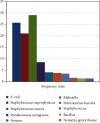Assessment of Bacterial Isolates from the Urine Specimens of Urinary Tract Infected Patient
- PMID: 35937407
- PMCID: PMC9348933
- DOI: 10.1155/2022/4088187
Assessment of Bacterial Isolates from the Urine Specimens of Urinary Tract Infected Patient
Retraction in
-
Retracted: Assessment of Bacterial Isolates from the Urine Specimens of Urinary Tract Infected Patient.Biomed Res Int. 2024 Jan 9;2024:9861081. doi: 10.1155/2024/9861081. eCollection 2024. Biomed Res Int. 2024. PMID: 38230077 Free PMC article.
Abstract
Urinary tract infections (UTIs) maintained a serious public health concern, as did the growth in antibiotic resistance both between uropathogenic microorganisms. A regular assessment of the microbiological agents that cause UTIs, as well as their antimicrobial resistance, is essential for a tailored empirical antibiotic response. Knowing the variables that cause UTIs can help you intervene quickly and simply to get the condition under control. The most common infecting species in acute infection is Escherichia coli (E. coli). To strengthen infection control strategies, it is necessary to know the prevalence and location of UTI. The goal of this research is to measure the frequency of microorganisms isolated from patients with UTIs as well as the antimicrobial sensitivity characteristics of Gram-negative bacteria. The purpose of this research has been to evaluate the frequency of UTIs by extracting and characterizing the various bacterial etiological organisms, as well as to assess the factors linked to UTIs. The goal of this research is to identify, characterize, and establish the antibiotic susceptibility patterns of bacteria linked to urinary tract infections. Fresh collected urine specimen was taken from inpatients or outpatients in UTI cases and bacteriologically tested using conventional microbiological methods. The Kirby-Bauer disc diffusion method was used to create the antibiogram. Staphylococcus saprophyticus, Staphylococcus aureus (28%), and Escherichia coli (24.6%) were the most common isolates (20%). The evaluated agents' antibacterial activity was all in the following order: cefixime, ciprofloxacin, augmentin, gentamicin, ceftazidime, nitrofurantoin, ofloxacin, and cefuroxime. It was discovered that each and every one of the microbes exhibited varied degrees of resistance to the antibiotics nitrofurantoin, ciprofloxacin, and ofloxacin. Every type of bacteria, with the exception of those belonging to the genus Streptococcus, has a Multiple Antibiotic Resistance Index (MARI) that is more than 0.2. The first-line therapies for urinary tract infections (UTIs) in the region would consist of ciprofloxacin, ofloxacin, and nitrofurantoin. Lower urinary tract infections almost never result in problems if they are diagnosed and treated as soon as possible and in the correct manner. However, if treatment is not sought, a urinary tract infection can lead to serious complications.
Copyright © 2022 Chennu M. M. Prasada Rao et al.
Conflict of interest statement
The authors declare that there are no conflicts of interest regarding the publication of this paper.
Figures








Similar articles
-
Antimicrobial Evaluation of Bacterial Isolates from Urine Specimen of Patients with Complaints of Urinary Tract Infections in Awka, Nigeria.Int J Microbiol. 2016;2016:9740273. doi: 10.1155/2016/9740273. Epub 2016 Apr 20. Int J Microbiol. 2016. PMID: 27200093 Free PMC article.
-
Risk factors for ciprofloxacin resistance among Escherichia coli strains isolated from community-acquired urinary tract infections in Turkey.J Antimicrob Chemother. 2005 Nov;56(5):914-8. doi: 10.1093/jac/dki344. Epub 2005 Sep 20. J Antimicrob Chemother. 2005. PMID: 16174685
-
Antimicrobial Resistance in Bacteria Causing Urinary Tract Infections.Comb Chem High Throughput Screen. 2022;25(7):1219-1229. doi: 10.2174/1386207324666210622161325. Comb Chem High Throughput Screen. 2022. PMID: 34161207
-
Antibiotic Resistance Among Uropathogenic Escherichia coli.Pol J Microbiol. 2019 Dec;68(4):403-415. doi: 10.33073/pjm-2019-048. Epub 2019 Dec 5. Pol J Microbiol. 2019. PMID: 31880885 Free PMC article. Review.
-
An update on the management of urinary tract infections in the era of antimicrobial resistance.Postgrad Med. 2017 Mar;129(2):242-258. doi: 10.1080/00325481.2017.1246055. Epub 2016 Oct 21. Postgrad Med. 2017. PMID: 27712137 Review.
Cited by
-
Retracted: Assessment of Bacterial Isolates from the Urine Specimens of Urinary Tract Infected Patient.Biomed Res Int. 2024 Jan 9;2024:9861081. doi: 10.1155/2024/9861081. eCollection 2024. Biomed Res Int. 2024. PMID: 38230077 Free PMC article.
-
Patterns of Drug Resistance and Bacterial Pathogen Distribution in Patients with Urinary Tract Infections in the Jiaxing Region from 2020 to 2022.Infect Drug Resist. 2023 Sep 6;16:5911-5921. doi: 10.2147/IDR.S424158. eCollection 2023. Infect Drug Resist. 2023. PMID: 37700799 Free PMC article.
-
Epidemiological insights into seasonal, sex‑specific and age‑related distribution of bacterial pathogens in urinary tract infections.Exp Ther Med. 2024 Feb 14;27(4):140. doi: 10.3892/etm.2024.12428. eCollection 2024 Apr. Exp Ther Med. 2024. PMID: 38476915 Free PMC article.
References
-
- Mahdi B., Khudhur H. B., Abdul-Hussein M. M. Bacterial isolates of urine and their susceptibility to antimicrobials. Open Access Maced J Med Sci . 2020;8(A):84–88. doi: 10.3889/oamjms.2020.4086. - DOI
-
- Angoti G., Goudarzi H., Hajizadeh M., Tabatabaii Z. Bacteria isolated from urinary tract infection among patients and determination of the antibiotic susceptibility patterns of the gram negative bacteria in Iran. Novelty in Biomedicine . 2016;4:1–4.
-
- Karthikeyan S., Ramkumar G., Aravindkumar S., Tamilselvi M., Ramesh S., Ranjith A. A novel deep learning-based black fungus disease identification using modified hybrid learning methodology. Contrast Media & Molecular Imaging . 2022;2022, article 4352730 doi: 10.1155/2022/4352730. - DOI - PMC - PubMed
-
- Abubakar B. M., Abubakar A., Tela U. M., et al. An appraisal on antibiotic susceptibility of common bacterial pathogens in urinary tract infections at a Nigerian Tertiary Health Center. Arch Int Surg . 2017;7(2):p. 56. doi: 10.4103/ais.ais_17_17. - DOI
Publication types
MeSH terms
Substances
LinkOut - more resources
Full Text Sources
Medical

